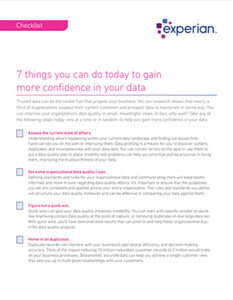- Products

Enjoy a free 30-day trial of our
data validation software.Experience the power of trusted data
solutions today, no credit card required! - Solutions

Enjoy a free 30-day trial of our
data validation software.Experience the power of trusted data
solutions today, no credit card required! - Partners

Enjoy a free 30-day trial of our
data validation software.Experience the power of trusted data
solutions today, no credit card required! - Learn more
- Pricing
- Contact Us
Data integrity
Once you correct your data mistakes, ensuring that the data is valid is critical to success.
Improve your data integrity todayData integrity solidifies your data management strategy by assessing its validity and authenticity. Where data quality fixes the mistakes, data integrity ensures that the data is accurate.
At the end of the day, it’s what you do with your quality data that matters—that’s where data integrity comes in. Make sure you build your data management plan with a sturdy foundation and an inflow of quality data. Without this, you won’t be able to use your information to the best of its ability.
Data integrity helps you unlock the true potential of your data so you can drive your business forward.
40% of organizations lack trust in the data needed to achieve their key business objectives
— 2019 Global Data Management Report
Why data integrity is important
More than a third of businesses don’t trust their data. Do you trust your data for your business? Build a data management plan that brings you valid, authentic, and quality data that you can use to execute on other business strategies. In other words, make sure you have data integrity.
Data integrity is important because it keeps the process going. With a constant flow of data, the integrity of the information is what allows you to maintain a database that is unimpaired and complete.[1]
Sure, it’s great to have massive amounts of data flowing throughout your organization, but it isn’t useful if it’s not of high quality. To override these common data integrity issues, make sure you have a manageable amount of data flowing through your database, reliable sources, and modern practices that stay on top of the inflow of quality data.
Kempe, Shannon. Data Integrity Rules 1.” Dataversity.net.
Data integrity vs. data quality
Data quality and data integrity intersect. Data quality involves the completeness, accuracy, timeliness, and consistency of stored data, while data integrity checks for its validity and authenticity. Both are important for building a database that users trust with business-critical decision making.
Let’s consider some examples of data integrity issues vs. data quality issues that relate to address, phone, and email data to show the difference between the two.
However, though data integrity is a critical part of maintaining data accuracy, it is just one of many components in managing the overall quality of your data.
Explore data quality management today
7 things you can do today to gain more confidence in your data
Are you skeptical of your data’s quality and effectiveness? Here are 7 tips to help make your data more trustworthy.
Get the tip sheet